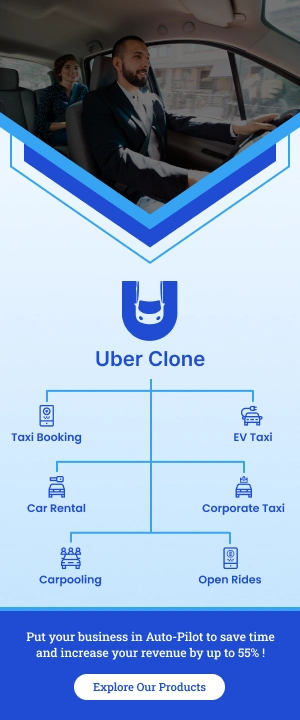
If you are planning to start a ride-hailing business, choosing the right technology is just one crucial part of it. The real differentiator? Your business model. Only a tailored model can cut through the competition and enable a smooth market entry. To help you do that, we have crafted a comprehensive breakdown of Uber clone business models.
The types of diverse taxi business models are organized into strategic categories based on service type, audience preference, and operational structure. Let’s understand each one of them in detail.
Complete Categorized List of Uber Clone Business Models
Below is a fully organized list of Uber clone business models that entrepreneurs can consider to start a taxi booking business.
All these diverse types of taxi business models are designed to align with customers’ pain points and real-world mobility challenges.
Service-Type Business Model
A service-type business model refers to an approach that offers multiple categories of ride services, each defined by different vehicle types, pricing, or purpose. It enables customers to choose a ride based on their specific needs, such as comfort and affordability.
Standard Ride-Hailing
This is the most common taxi booking business model, where customers book a cab for point-to-point travel. In a standard ride, different types of taxis are available for customers.
Best Suited For? – Metro cities with established driver networks.
Bike Taxi
Offers bike ride services for short-distance travel to urban commuters. It is ideal for targeting solo travelers, college students, and those navigating congested traffic zones.
According to Market Research Future, increasing environmental awareness is a prominent factor driving the growth of the bike taxi market.
Rapido India is a successful example of the Bike Taxi business scaled by expanding it in tier 2 and tier 3 cities.
Best Suited For? – Budget-conscious customers with high-traffic areas.
Ride-Sharing / Pooling
In ride-sharing, multiple customers share the same vehicle, dividing the fare among them. With this model, businesses can get higher revenue per km and gain the advantage of better asset utilization.
Best Suited For? – It works best in traffic-dense cities and budget-sensitive populations.
Outstation / Intercity
Outstation intercity travel includes pre-booked cabs for long-distance travel. This model is particularly useful for businesses catering to tourists or business travelers.
Travelers often book such rides for leisure trips, weekend getaways, or business travel. The platform can also offer one-way or round-trip options.
Best Suited For? – Cities with tourism potential or strong business corridors.
Target Audience-Based Models
The target-based business model refers to catering to specific groups, such as employees, kids, and pet owners, to make taxi services more aligned with their needs.
Corporate Taxi
As per an article by the Business Research Company, corporate partnerships for on-demand ride-hailing are one of the major trends in the ride-hailing market.
This is a B2B taxi booking business model that focuses on corporations that want an on-demand mobility service for their employees. This is beneficial for companies that prefer recurring revenue streams with long-term contracts rather than relying solely on a B2C approach.
With this service, companies can book daily commutes, airport transfers, team travel, and late-night drop-offs.
Best Suited For? – Companies wanting additional, recurring revenue streams and long-term partnerships.
Kid-Friendly Taxi
This model can be built around safety features for children. Companies can collaborate with schools and tuition classes for a steady demand flow.
Unlike the traditional taxi business model, a kid-friendly taxi solves a very real problem for parents. So, once trust is established, families and educational institutions can become long-term customers for the business.
Best Suited For? – Mobility startups targeting repeat-use school transport with niche loyalty and premium family plans.
Pet-Friendly Taxi
Pet-friendly taxis offer ride services that accommodate passengers traveling with pets. It’s a smart business strategy that caters to an emotionally driven and underserved market.
Pet owners frequently travel to grooming salons, parks, and daycare centers. Once they find your service reliable, they become long-term loyal users.
Best Suited For? – Businesses aiming to target a niche market and create a USP.
Women-Only Taxi
Women-only taxi booking businesses are focused on empowering women drivers and on the safety and comfort of women passengers. Female riders who prefer safety are likely to be long-term customers.
This model not only creates a competitive edge for the business but also builds brand credibility by offering value-driven services.
Best Suited For? – Businesses that are operating in cities with gender safety concerns.
Sustainability-Driven Models
A sustainability-driven taxi business model helps the business to stand out in the market by catering to the eco-friendly customer segment.
EV Fleet
The EV fleet model focuses on offering customers EV ride-hailing services. Fuel pollution and sustainability are among the most significant environmental concerns of our time. There is a huge segment of customers who prefer EV rides over regular ones.
The global EV market size is projected to grow at a CAGR of 18.4% by 2032. This showcases huge potential for EV-based ride-hailing businesses.
Moreover, with EV-based models, businesses can reduce fuel costs while enhancing their brand image in the market.
Best Suited For? – Businesses operating in cities with EV charging infrastructure and pollution regulations.
Monetization-Based Models
A monetization-based model in the taxi booking business refers to finding various ways to generate revenue and create a sustainable income.
Commission-Based
In a commission-based model, the platform earns a fixed percentage on every ride. This model is simple, scalable, and widely adaptable. Typically, the commission is charged to the driver, rider, or both.
Best Suited For? – Startup founders looking for steady and scalable margins for their taxi business.
Subscription-Based (Riders/Drivers)
In a subscription-based taxi booking model, business drivers or riders pay a fixed fee to the platform to access the service. These fees can be on a weekly, monthly, or annual basis. It provides a predictable earnings flow for the business, making its finances more secure.
Best Suited For? – Businesses operating in markets with high-frequency customers and a loyal driver base.
White-label Licensing
Entrepreneurs purchase a license or white-label platform to launch their taxi services and brand them under their business name.
Since the white-label platform providers are generally experienced, it ensures robust tech infrastructure and allows entrepreneurs to focus on growth rather than development complexities.
Best Suited For? – New entrants and local taxi operators looking to expand digitally.
Taxi + Advertising
It’s a hybrid business model where ride-hailing companies earn income through service fees, other streams, and advertising.
They can do in-app advertising, vehicle branding, or collaboration with other brands.
Best Suited For? – Urban fleets with consistent daily ridership and a huge number of app downloads.
Operational Models
Taxi Aggregator
Connects individual taxi drivers to customers via a centralized app. The platform handles customer acquisition, booking, and payments while drivers manage their vehicles.
Best Suited For? – Startups entering markets with a large pool of independent drivers.
Taxi Franchise
Franchisees operate under your brand, utilizing a standardized system, and pay franchise and licensing fees. Ideal for regional expansion without owning every fleet.
Best Suited For? – Entrepreneurs looking to scale across geographies.
Your Taxi Booking Business Model Deserves a Real Platform That Helps You Launch, Manage & Scale! Let’s Turn Your Idea Into a Thriving Taxi Brand
Comparative Table for Different Uber Clone Business Models
The table below provides valuable insights into the revenue potential, target audience, key features to include, and the ideal region for launching your taxi booking business.
| Business Model | Revenue Potential | Target Audience | Key Features | Ideal Launch Region |
|---|---|---|---|---|
| Standard Ride-Hailing | High (Daily Volume) | General commuters | Real-time booking, GPS tracking, surge pricing | Metro cities, Tier 1 |
| Bike Taxi | Moderate | Students, solo riders | Two-wheeler support, quick booking, and low fares | Tier 2 cities, college hubs |
| Ride-Sharing / Pooling | Moderate to High | Budget-conscious riders | Fare splitting, route matching, and multi-user support | Urban zones, eco-conscious areas |
| Outstation / Intercity | High (Per Trip Margin) | Travelers, tourists | Long-distance routing, fare calculator | Tourist corridors, highways |
| Corporate Taxi | High (Recurring Contracts) | Businesses, employees | Multi-user billing, branded dashboards | Business districts, IT parks |
| Kid-Friendly Taxi | Moderate | Parents, schools | Child-safe vehicles, parental tracking | Residential zones, school areas |
| Pet-Friendly Taxi | Low to Moderate | Pet owners | Pet seat options | Urban pet-friendly zones |
| Women-Only Taxi | Moderate | Female riders/drivers | SOS alerts, female driver onboarding | Safety-sensitive regions |
| EV Fleet | High (Green Incentives) | Eco-conscious users | EV support, charging station locator | Green cities, government zones |
| Commission-Based | Moderate to High | General riders/drivers | Fare calculator, commission logic | Universal |
| Subscription-Based | High (Recurring Revenue) | Frequent riders/drivers | Plan management, auto-renewal | Urban, corporate, student zones |
| White-label Licensing | High (One-time + SaaS) | Taxi operators, startups | Admin panel, customization tools | Global, franchise markets |
| Taxi + Advertising | Moderate to High | Local businesses, riders | Ad placement, geo-targeting | High-footfall urban zones |
| Taxi Aggregator | High (Platform Leverage) | Independent operators, startups | App-based dispatch, unified platform, rating system | Urban zones, Tier 1, Tier 2 |
| Taxi Franchise | Moderate to High | Regional entrepreneurs | Brand licensing, operational support, standard fleet norms | Expanding cities, satellite towns |
Conclusion
The Uber clone business models mentioned in this blog are not just options; they are strategic plans designed for entrepreneurs to fill the market gap. By aligning your business model with your target audience’s needs, you can drive sustainable growth and foster long-term loyalty.
The right business model not only supports the growth of your taxi booking venture but also defines market positioning and unlocks new monetization pathways. Contact us to bring your business model to life with Uber clone app development that fuels exceptional efficiency for your taxi booking business.
Frequently Asked Questions

